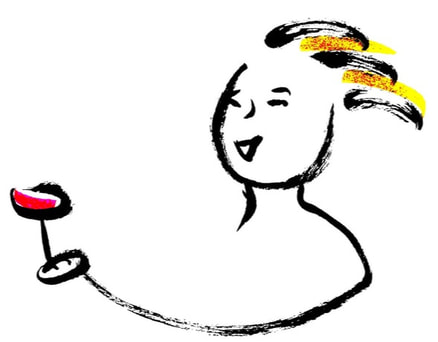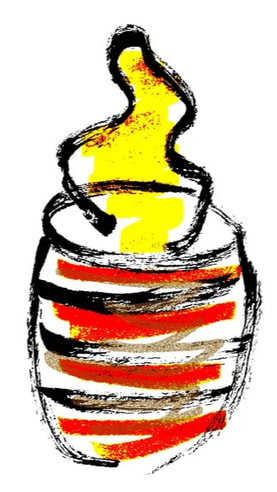 The winemaker tastes the wine in each barrel to follow its unique characteristics. The winemaker tastes the wine in each barrel to follow its unique characteristics. When my mouth waters for wines with oak characteristics, I might first think of red Bordeaux variety grapes such as Cabernet Sauvignon or Carménère because they are traditionally aged in oak, whether as blends (customary) or single variety offerings (gaining in popularity). In discussing oak aging, we often think of reds first, but whites are also part of the picture. Just yesterday I ordered a R de Rieussec 2017 Bordeaux that is roughly half Sémillon (a grape that fascinates me) and half Sauvignon Blanc (also fascinating, but for different reasons). This wine is produced as a dry white in a sub-region of Sauterns that neighbors Château d’Yquem, a sweet white wine producer in a league of its own. If you you appreciate the effects of oak in wine, you are not alone. Many of the world’s fine wines are aged in casks, giving the wines added complexity, richness, flavor and body. Oak imparts wonderful flavor compounds such as vanilla, spices, caramel, and smokiness. The winemakers of Burgundy are known for pioneering techniques to shape the flavors and richness of Chardonnay, including the use of old barrels, in both fermentation and aging. In addition to barrels, both whites and reds can be aged in stainless steel, concrete, amphoras, and other vessels, depending upon the choices of the winemaker. The R de Rieussec was barrel aged, and I can’t wait to receive the delivery at my doorstep in a few days. Most white wines around the world are fermented in stainless steel tanks, giving the maker control over temperature, oxygen ingress and egress, and other elements of winemaking. Stainless steel tanks are a safe bet for the fermentation of whites. However, some vintners choose to ferment a portion of their white wine in oak barrels, like the making of the wine I just ordered. Twenty percent of the wine is fermented in barrels while the balance is directed to large vats for fermentation. Eventually, the barrel-fermented wine is blended with the batch from the large vats. The winemaker tastes the wine in each barrel to follow its unique characteristics, then decides how much from that barrel will be blended into the whole. This process allows for quite a bit of creativity in the final outcome of the wine. Fermentation in new oak provides expressive flavor and noticeable texture to white wine. If the winemaker ferments in previously used or old, neutral barrels, mostly the texture, rather than the flavor, will be affected. Red wines require hands-on activities during fermentation to break up the cap of pulp and skins that build up on the surface of the wine. Techniques such as “punching down” ensure that this thick matter is redistributed into the wine so that the color, flavors and tannins will be properly extracted. The intervention that red wine requires makes it practical to use large vessels rather than wine barrels for fermentation. When I ferment wine at home, I gently push down on the pulp and skins and stir them into the wine. This stirring helps to cool the wine when fermentation is intense and the temperatures rises. Part of my mothering of the wine is to monitor the temperature at least twice daily, and I keep dry ice on hand to cool the wine if necessary. If the fermentation temperature gets too hot, the health of the yeast is at risk and the warmth may attract undesirable organisms. The result can be wine with stewed fruit flavors and muted aromatics . . . wine that is a disappointing shadow of what it could have been. If the fermentation temperature is too low, the yeast can go dormant and stop working. Nobody likes a stuck fermentation. When that happens, you have to figure out how to wake up the yeast so that fermentation can continue until the wine is dry or deal with an end product that is undeveloped and sweeter than planned. Since sweet wines are not as popular in the market as in the past, most makers do everything possible to nurture the yeast throughout fermentation to ensure a dry finish. During winemaking with grapes, I take sugar readings, taste the wine, examine the skins, seeds, pulp and liquid throughout the fermentation. In this manner, I develop an intimate relationship with the wine, as do many winemakers. Driving the fermentation is my favorite part of homebrewing. Perhaps car lovers feel this love when they take an excursion in a nifty car, especially a stick shift, where you effectively become a part of the machinery that enables the drive.  As wines age, reds lose color while whites grow darker. As wines age, reds lose color while whites grow darker. I once incorporated maple syrup with the juice from apples to create what is known as an acer cider. If you have ever tasted the juice of freshly pressed apples, you know that it is very sweet. The maple syrup I added introduced additional sugar to the mix, overwhelming the yeast and the fermentation stalled after a few days. I tried adding more yeast in hopes of restarting the action but it became clear that the yeast could not survive in that environment. There was more sugar there than the yeast could process. Note to self: use less maple syrup the next time. Luckily it was a small test batch. I considered throwing out the acer cider, but then remembered reading about an ancient civilization that fermented wine to about four percent then fortified it with spirits and botanicals. (Fortification is the addition of a distilled spirit, often brandy, to a wine either during or after fermentation.) I decided to give this approach a try since my acer cider had fermented to four percent. The botanicals and alcohol balanced out the sweetness of the cider and stabilized it, and my dinner guests enjoyed it as an after-dinner drink. It is very helpful to continuously learn from others, including ancient civilizations, when it is time for problem-solving. Speaking about oak, my mind also jumps to Spain, where oak aging is central to the production of that country’s signature grape, Tempranillo. I might also think about an obscure but fascinating wine region, such as the Jura in eastern France, where the wine is matured in oak under a veil of yeast to create the exotic vin jaune, one of the world’s most intriguing and rare wines. Vin jaune is a dry wine produced in a manner that is similar to Spain’s Fino Sherry, which is also dry and complex, relying heavily on yeast for protection and development. Vin jaune is produced from Savagnin grapes, while Fino Sherry is made with Palomino Fino grapes. Another difference between the two is that Fino Sherry is a fortified wine while Vin jaune is not. Of course, when it comes to oak aging, there is also Italy to think about. Barolo wines, made from the Nebbiolo grape, need time in oak to calm their tannins and aid in their evolution. Really, it is difficult to name even one winemaking country that does not use oak to mature their wines gracefully. The list below spotlights the grapes that makers might look to first when considering the use of oak. During winemaking with grapes, I take sugar readings, taste the wine, examine the skins, seeds, pulp and liquid throughout the fermentation. In this manner, I develop an intimate relationship with the wine, as do many winemakers. Most grape varieties do well with oak aging, except those that are sensitive to the effects of oxygen. In those cases, the wines will likely be aged in steel or concrete tanks, or the winemaker will blend these delicate wines with other heartier grape varieties before placing them in a barrel. Some varieties have distinctive aromas that the winemaker wants to accentuate, as is common with Grüner Veltliner, Sauvignon Blanc and Riesling. In this case, the goal is to preserve fruit purity with no oak flavors and other influences getting in the way. The decision on whether or not to use oak is driven by the winemaker’s intent and creativity, customs, wine laws, budget, and other factors. French and American oak barrels are often favored by winemakers, though oak can be sourced from many countries. Incidentally, barrels can be made from other types of wood, such as chestnut or acacia, but oak is much more common. France’s tight-grained oak delivers subtle spice, cedar, hazelnut and smoky notes along with silky textures. The comparatively looser-grained American oak is more forthright, boldly contributing vanilla, coconut and cinnamon flavors along with a creamy texture. Older trees tend to have the tightest grains regardless of location. For some regions, the choice of oak has origins in history and politics rather than organoleptic preferences. The Spanish have a long history of disagreements and consequently wars with France. From the sixteenth to the nineteenth century, the Spanish Empire owned some of what is now American land, including Florida, and this access to North America provided a ready resource for sourcing oak without having to deal with the French. To be made into casks, oak needs to be air-dried, seasoned and toasted over fire. The amount of toasting dramatically affects the finished wine’s flavor. The higher the toast, the more oak influence you will find in the wine. New wine barrels release more intense flavors than used barrels. With each use of the barrel, the flavors imparted by the wood become less pronounced in the wine. There is a trend toward a more subtle use of oak as wine drinkers and critics increasingly favor subtlety and nuance in fine wine. Moreover, wines with subtle oak influences are more easily accessible to drinkers and are ready to drink now, in contrast to heavily oaked wines that require time to calm down the intensity. Casks permit the slow ingress of oxygen, smoothing it out and aiding in the wine’s development. Some of the wine is lost to evaporation when it is being aged; this is known as the “angel’s share.”  The amount of the casks's toasting dramatically affects the finished wine's flavor. The amount of the casks's toasting dramatically affects the finished wine's flavor. Each cask holds several gallons of wine inside its staves (planks), further concentrating the wine for more pronounced flavors. Small casks come into more contact with wine than large casks and therefore take on oakier character. Oak vessels provide an ideal environment for the the natural chemical conversions that wine undergoes as it matures. Winemakers can add oak chips or staves to wine in lieu of using expensive barrels. These additions will add flavor but will not influence the texture of a wine as would a cask. The use of oak chips or staves or even oak powder is one way that mass producers make low-cost wines available to the public. The amount of time the wine spends in oak also affects the intensity of the wine’s flavors and textures. A fine red wine aged for two years in new oak will have characteristics that are very different from a fine red wine aged for ten years in new oak. As the two-year-old red ages, the tannins will smooth out. Primary fruit flavors will concentrate and evolve from fresh-fruit characteristics to those of dried fruit. Other flavors heretofore hidden by the bold fresh fruit come into their own over time. Tertiary flavors, those of maturation, can include mushroom, tobacco, forest floor and leather in reds. White tertiary flavors might be ginger, honey and cinnamon. The wine’s color will change, with reds losing color while whites grow darker. The spicy notes imparted into the wine from the cask will mellow. Wine evolves throughout its life cycle and the day you open the bottle, you capture the wine at a particular stage of development. That being said, the majority of wines are intended by the producers to be enjoyed upon release to the public. Whites: Chardonnay Friulano Godello Palomino Fino/Listán Blanco Pinot Blanc (Alsace) Savagnin Sémillon/Semillon Viognier Viura/Macabeo Reds: Aglianico Barbera Cabernet Franc Cabernet Sauvignon Carménère Dornfelder Garnacha/Grenache Graciano Malbec Merlot Mourvèdre/Mataro/Monastrell Nebbiolo Nero d’Avola Pignolo Pinotage Pinot Noir Petit Verdot Sagrantino Sangiovese Syrah/Shiraz Tannat Tempranillo Primitivo/Zinfandel This is one in a series of Grape Detective blogs featuring the attributes of wine and how your love for a specific wine grape may lead you to discover new grapes with similar characteristics. The focus of the list is grape variety and does not include blends, wine regions, or styles.
0 Comments
Leave a Reply. |
AuthorLyne Noella Archives
October 2022
Categories
All
|


 RSS Feed
RSS Feed
